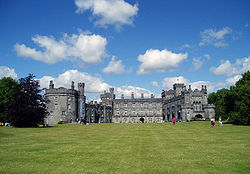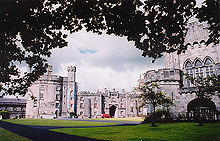Kilkenny Castle
| Kilkenny Castle | |
|---|---|
Irish: Caisleán Chill Chainnigh | |
 | |
| General information | |
| Type | Castle |
| Location | Kilkenny, Ireland |
| Completed | 1260 |
Kilkenny Castle (Irish: Caisleán Chill Chainnigh pronounced [ˈkaʃlʲaːnˠˈçiːl̪ʲˈxan̪ʲiː]) is a castle in Kilkenny, Ireland, built in 1260 to control a fording-point of the River Nore and the junction of several routeways. It was a symbol of Norman occupation, and in its original 13th-century condition, it would have formed an important element of the town's defences with four large circular corner towers and a massive ditch, part of which can still be seen today on the Parade.
In 1967, Arthur Butler, 6th Marquess of Ormonde, sold the castle for £50 to the Castle Restoration Committee for the people of Kilkenny. The castle and grounds are now managed by the Office of Public Works, and the gardens and parkland are open to the public. The Parade Tower is a conference venue. Since 2002, ceremonies for conferring awards and degrees on the graduates of the Kilkenny Campus of the National University of Ireland, Maynooth, have been held at the castle.
History
[edit]




Early history
[edit]Richard de Clare, 2nd Earl of Pembroke, commonly known as Strongbow constructed the first castle, probably a wooden structure, in the 12th century. The Anglo-Normans had established a castle in 1173, possibly on the site of an earlier residence of the Mac Giolla Phádraig kings of Osraighe. Kilkenny formed part of the lordship of Leinster, which was granted to Strongbow. Strongbow's daughter and heiress, Isabel married William Marshall in 1189.[1]
Marshall owned large estates in Ireland, England, Wales and France and managed them effectively. In 1192, he appointed Geoffrey FitzRobert as seneschal of Leinster and so began a major phase of development in Kilkenny, including the development of Kilkenny Castle.[1] The first stone castle on the site, was completed in 1260. This was a square-shaped castle with towers at each corner; three of these original four towers survive to this day.[2]
The castle was owned by the seneschal of Kilkenny Sir Gilbert De Bohun who inherited the county of Kilkenny and castle from his mother in 1270, in 1300 he was outlawed by Edward I but was reinstated in 1303, he held the castle until his death in 1381. It was not granted to his heir Joan, but seized by the crown and sold to the Butler family in 1391.[2]
Butlers of Ormonde
[edit]The Butler family (who changed their name from FitzWalter in 1185) arrived in Ireland with the Norman invasion. They originally settled in Gowran where James Butler, 3rd Earl of Ormond built Gowran Castle in 1385. The family had become wealthy and James bought Kilkenny Castle in 1391 and established himself as ruler of the area. The Butler dynasty then ruled the surrounding area for centuries. Many of the family, including James Butler, 3rd Earl of Ormond are buried in St. Mary's Collegiate Church Gowran.[3]
Among the many notable members of the Butler family was Lady Margaret Butler (c. 1454 or 1465–1539) the Irish noblewoman, the daughter of Thomas Butler, 7th Earl of Ormond. Lady Margaret Butler was born in Kilkenny Castle. She married Sir William Boleyn and was the paternal grandmother of Anne Boleyn, second wife of King Henry VIII of England.[4]
Confederate Ireland
[edit]In the 17th century, the castle came into the hands of Elizabeth Preston, wife of then Lord Lieutenant of Ireland, James Butler, 1st Duke of Ormond. Butler, unlike most of his family, was a Protestant and throughout the Irish Confederate Wars of the 1640s was the representative of Charles I in Ireland. However, his castle became the capital of a Catholic rebel movement, Confederate Ireland, whose parliament or "Supreme Council" met in Kilkenny Castle from 1642 to 1648. Ormonde himself was based in Dublin at this time. The east wall and the northeast tower of the Castle were damaged in 1650 during the siege of Kilkenny by Oliver Cromwell during the Cromwellian conquest of Ireland. They were later torn down. Then, in 1661, Butler remodelled the castle as a "modern" château after his return from exile.[5]

By the 18th century, the castle had become run down, reflecting the failing fortunes of the Butler family. However, some restoration was carried out by Anne Wandesford of Castlecomer, who brought wealth back into the family upon marrying John Butler, 17th Earl of Ormonde. In the 19th century, the Butlers then attempted to restore it to its original medieval appearance, also rebuilding the north wing and extending the south curtain wall. More extensions were added in 1854. In 1904, King Edward VII of the United Kingdom of Great Britain and Ireland and his wife Queen Alexandra visited Kilkenny Castle.[6]


The castle in the 20th century
[edit]The family disposed of the bulk of their tenanted estates in Tipperary and Kilkenny, 21,000 acres (85 km2), by 1915 for £240,000.[7] James Butler, 3rd Marquess of Ormonde, died in 1919. Death duties and expenses following his death amounted to £166,000.[7]
As Lord Ormonde had only two daughters, it was agreed that, in order to reduce the double-taxation of the estate, his brother and heir, Arthur Butler, 4th Marquess of Ormonde would forgo his inheritance in favour of his son, George Butler, 5th Marquess of Ormonde who used the courtesy title 'Earl of Ossory'. Lord and Lady Ossory took up residence in the Castle in 1921, with their children Antony, Viscount Thurles and Lady Moyra Butler.[8]
In 1922, during the Irish Civil War, Republicans were besieged in the Castle by Irish Free State forces. The Ormondes, together with their pet Pekinese, chose to remain in situ in their bedroom over the great gate, which was the main focus of attack. There was a machine gun outside their door. Only one man was injured but a great deal of damage was inflicted on the castle, which took many years to repair.[9]
George Butler, Earl of Ossory and his family remained living in the castle until 1935,[2] when they sold its contents for £6,000, moved to London, and abandoned it for thirty years.[10] The impact of rising taxes, death duties, economic depression and living costs had taken their toll. While the Ormondes had received £22,000 in rental income in the 1880s, investment income in the 1930s was in the region of £9,000 and by 1950 these investments yielded only £850.[7]
In 1938, Arthur, George and Antony Butler agreed to resettle the Trust in which the estates were held. Antony Butler, Viscount Thurles died unexpectedly in 1940, and therefore after the death of the 4th Marquess in 1943 and the 5th Marquess in 1949, the estate was inherited by Arthur Butler, 6th Marquess and 24th Earl of Ormonde.[8]
In 1967, this Lord Ormonde sold the abandoned and deteriorating castle to the Castle Restoration Committee for a ceremonial £50, with the statement: "The people of Kilkenny, as well as myself and my family, feel a great pride in the Castle, and we have not liked to see this deterioration. We determined that it should not be allowed to fall into ruins. There are already too many ruins in Ireland." He also bought the land in front of the castle from the trustees "in order that it should never be built on and the castle would be seen in all its dignity and splendour". The handover ceremony also marked the foundation of The Butler Society,[11] a still thriving organisation that connects, preserves and unites a family once dominant in the British Isles. Mick Jagger and Marianne Faithfull turned up at the castle hand over party, with Jagger telling the newspapers "We just came to loon about."[12] It now belongs to the people of Kilkenny.[13]
Restoration
[edit]The rest of the 20th century saw a large amount of restoration and maintenance take place, as well as the castle being opened to visitors.[14]




Butler Gallery
[edit]The Butler Gallery, previously based in the long gallery of Kilkenny Castle,[15] is located in the redeveloped Evans' Home, a former almshouse built in the 19th century for impoverished domestic servants.[16][17] It holds rotating exhibitions put on by the Kilkenny Art Gallery Society in a venue named for Peggy and Hubert Butler.[18]
Excavations
[edit]Excavations and building surveys by Ben Murtagh in the 1990s revealed traces of an earlier castle, exposed a postern gate (side entrance) and section of the castle ditch facing on to the Parade (now visible), and also partly uncovered the lost south-east side of the castle. The entrance was through the (now missing) east wall. Various other features of the original castle have also been excavated, including original stone buttressing and a garderobe.[19] Excavations in 2019 by Cóilín Ó Drisceoil uncovered the foundations of the great gatehouse, built by William Marshal in the early 1200s.[20]
Weather record
[edit]Ireland's highest officially recognised air temperature, 33.3 °C (91.9 °F), was measured at Kilkenny Castle on 26 June 1887.[21]
Burials in the crypt
[edit]References
[edit]- ^ a b Painter, Sidney (1982). William Marshal, Knight-Errant, Baron, and Regent of England. University of Toronto Press. pp. 151–152. ISBN 978-0802064981.
- ^ a b c "1837 – Kilkenny Castle, Co. Kilkenny". Archiseek. Retrieved 3 November 2019.
- ^ A History of St. Mary’s Church. Text by Imelda Kehoe. Published by the Gowran Development Association 1992
- ^ Loade, David (2011). The Boleyns: The Rise & Fall of a Tudor Family. Amberley Publishing. p. 31. ISBN 978-1445603049.
- ^ Sweet, Rosemary (2002). Provincial Towns in Early Modern England and Ireland: Change, Convergence and Divergence - Provincial Culture and Urban Histories in England and Ireland during the Long Eighteenth Century. British Academy. ISBN 9780197262481. Retrieved 3 November 2019.
- ^ "Royal Visit". Historic Kilkenny. Retrieved 3 November 2019.
- ^ a b c Dooley, Terence (2001). The Decline of the Big House in Ireland. Wolfhound Press Ltd. ISBN 0-86327-850-7.
- ^ a b "Marquess of Ormonde". Cracrofts Peerage. Retrieved 3 November 2019.
- ^ Melosina Lenox-Conyngham (21 August 2006). "An Irishman's Diary". The Irish Times.
- ^ "Lords of the Castle". Archived from the original on 10 February 2012. Retrieved 11 February 2016.
- ^ "The Butler Society". Retrieved 3 November 2019.
- ^ "Irish Tourism Website".
- ^ National Parks and Monuments Service, Kilkenny Castle
- ^ "Kilkenny Castle Guide". Kilkenny Information Age. Archived from the original on 2 March 2010. Retrieved 22 March 2007.
- ^ "Press Release: New Museum Opens in Kilkenny". butlergallery.ie. 6 August 2021. Retrieved 24 June 2021.
Butler Gallery, previously located at Kilkenny Castle, has moved to Evans' Home
- ^ "Heritage - Evans' Home". butlergallery.ie. Retrieved 24 June 2021.
- ^ "Mccullough Mulvin Architects Adds Two Metal-Clad Volumes To Convert Former Almshouse Into Art Gallery". worldarchitecture.org. 8 February 2021. Retrieved 24 June 2021.
- ^ "Butler Gallery". Retrieved 3 November 2019.
- ^ "Murtagh, B., (1993). The Kilkenny Castle Archaeological Project 1990--1993: interim report. Old Kilkenny Rev 4 (5). Vol 4(5), pp. 1101-1117". Archaeology data service. Retrieved 3 November 2019.
- ^ The Marshal Gatehouse at Kilkenny Castle · Tietzsch-Tyler, Dan • Ó Drisceoil, Coilin. (2021 - 2022) - In: The Castle Studies Group journal vol. 35 (2021/22)
- ^ "Weather Extreme Records for Ireland". Met Éireann. Retrieved 27 July 2019.
Bibliography
[edit]- Fenlon, Jane, The Ormonde Picture Collection. Dublin, Dúchas/Heritage Service, 2001 ISBN 978-0-94-684638-2 OCLC 48384172
- Murdoch, Tessa (ed.) (2022). Great Irish Households: Inventories from the Long Eighteenth Century. Cambridge: John Adamson, pp. 31–53 ISBN 978-1-898565-17-8 OCLC 1233305993


